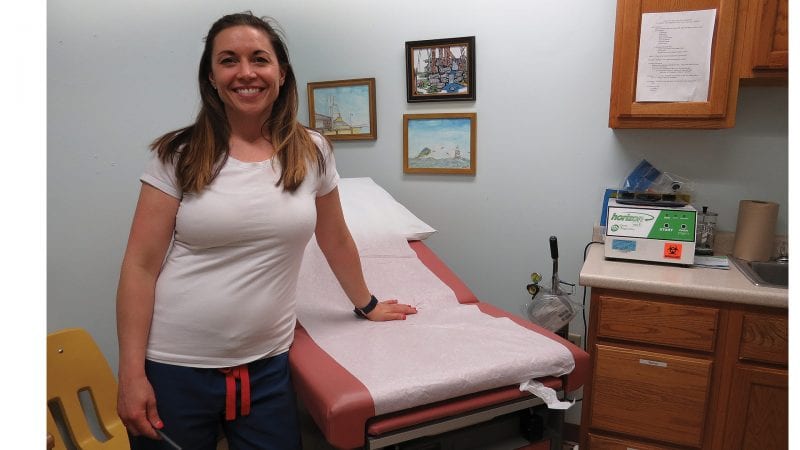Physician Caring for the Homeless Meets Patients Where They Are
A Day with ‘Dr. B’
By George O’Brien

It’s called a Section 12, and is otherwise known as a ‘pink slip,’ because that’s the color of the paper it’s written on.
“This is a determination that someone can’t maintain their own well-being in the community and is at serious risk of harm because of delusions or hallucinations or other mental illness,” said Dr. Jessica Bossie, primary-care physician for a program called Health Services for the Homeless, which is based in Springfield but serves most of Western Mass. “So they need protection from the community.”
Bossie came to the conclusion that a pink slip, something her office doesn’t like to do because it takes away the patient’s rights and autonomy — something this program always tries to preserve — was needed after a 40-minute session with her patient, during which she determined that action, in the form of an ER visit with the likelihood of a stay in a psychiatric bed, was needed.
“She understands the whole community here. She cares so much, and it takes someone very special to work with this population.”
Processing this Section 12 was the first act of what would have to be considered a typical day for Bossie, or ‘Dr. B,’ as she is called by many of her patients, most of whom have come to know and trust her over the years.
That’s because, while they come to her — in this case, at the small clinic within the homeless shelter in Northampton — she also comes to them. Bossie’s work during what she calls “outreach” (more on that later) takes her to the streets, under bridges, to homeless camps, and other locations where this population gathers.
Bossie is one of many individuals within the broad healthcare sector who are part of the 40 Under Forty class of 2021 recently announced by HCN’s sister publication, BusinessWest. In fact, she was the top scorer among nearly 200 nominees. Her story obviously resonated with a panel of five judges, and as you read more, you’ll see why.
But there are many other stories — 10 of them, in fact — from within the healthcare sector that impressed the judges, involving individuals in fields ranging from nursing to marketing and public relations to fitness .
Getting back to Bossie, the 34-year-old mother of three young girls told HCN that, dating back to her time at Boston University School of Medicine, she always intended to care for underserved populations, and was specifically interested in substance-abuse treatment. She had some direct exposure to Boston’s highly acclaimed healthcare program for the homeless, and has brought many of its best practices to this region.

She described her work as being 24/7 in nature, and, in general, it calls for caring for — and advocating for — a homeless population in Hampden, Hampshire, and Franklin counties that is bigger than most people would think. Her work involves treatment, but also prevention, and can vary from taking care of athlete’s foot (there’s a lot of that) to issuing pink slips to helping someone get off the streets and into housing.
To find out more about this energetic individual and the work she carries out, HCN spent a good chunk of a day with her recently in Northampton. Most of that time was spent at St. John’s Church, where meals were being served through the Manna Community Kitchen (meatloaf was on the menu) and COVID vaccinations were being administered.
A woman who preferred to be known as ‘Lisa’ was among those who stopped by. She described Dr. B as “a dynamo — a doctor of all trades,” who has helped her in many ways in the two years she’s been seeing her.
“She understands the whole community here,” she went on. “She cares so much, and it takes someone very special to work with this population.”
Primary Concerns
In most respects, it looks like a treatment room at a medical clinic, right down to the eye chart on the wall — and that’s exactly what it is.
But because of those being served, some of the supplies are different than what you would find at a typical clinic. For example, there are ample stores of sunscreen, said Bossie, who couldn’t say how much she dispenses during a typical day during the warmer months, other than to say it’s a large amount. There’s also a good supply of reading glasses, which she says she hands out “like candy.”
And then, there are the foot-care products, especially treatment for athlete’s foot, and socks — a large bag of them.
“Foot care is a big issue for this population,” she said, putting extra emphasis on that word ‘big.’ “They can’t keep their feet dry, and that leads to a lot of problems, especially athlete’s foot.”
Helping the homeless with such issues is just part of the daily and weekly regimen for Bossie, who brings, as noted, high energy and a considerable amount of passion to her work, which involves caring for the homeless population in what would be considered the I-91 corridor, a stretch from Springfield to Turners Falls.
“It’s hard to track the homeless because they come in and out, and they’re very transient. They don’t have an address; they don’t have a fixed location.”
When asked how big that population is, Bossie said it’s difficult to give a specific number, but she estimated it to be at least 2,000 people, a number that obviously fluctuates and has certainly increased given the financial difficulties many found themselves in due to COVID-19.
“It’s hard to track the homeless because they come in and out, and they’re very transient. They don’t have an address; they don’t have a fixed location,” she explained. “But the huge benefit of our organization is that we cross county lines and city lines. We’ll see a patient in Springfield one month, and when they move up to this area, we’ll follow them up here, and they’ll never lose their healthcare.”
As she cares for this population, Bossie splits up her week, with Mondays and Wednesdays in Springfield at a health center inside the 240-bed Friends of the Homeless facility on Worthington Street. Tuesdays and Thursdays are spent in Northampton, at the ServiceNet resource center and also in other locations like the Craig’s Doors shelter in Amherst. Fridays are generally devoted to large amounts of paperwork and planning.
When the shelters in Amherst and Northamton are closed, she undertakes street outreach in her recently purchased minivan, loaded with supplies.
“We treat burns, abscesses, tick bites … anything; I treated three patients recently for hepatitis C while they lived in a camp,” she said, adding that she has a map of these camps; a new one is created each spring.
On the Tuesday HCN visited, Bossie was working with the Northampton Health Department to deliver COVID vaccines to homeless patients, after what she described as a “really tough” morning during which she saw seven people. A quick recap of that morning provides some real insight into her work — and the dedication she brings to the job each day.
First, she saw the patient mentioned at the top, who was in mental-health crisis. The woman arrived so frightened of a delusion that she was planning to flee the state and had come to say goodbye. Fleeing would have left her without healthcare and without the support services she needed. Bossie’s team was successful at “talking the patient down” and getting her to agree to go to the emergency room for evaluation with the intention of placing her in “safe place” for several days.
Next, Bossie saw a recovering alcoholic, an individual who has been placed in housing, but still needs a significant amount of “hand holding.” Bossie said she sees her once a month to help keep her on the track to sobriety.
“She just completed detox and was making a run at staying sober,” she said. “That’s really hard after 45 years of using alcohol, and we’re totally down to support her.”
Subsequent visitors, most with a scheduled appointment, had a variety of different needs, including an untreated broken arm, various types of addictions, and a patient on oxygen with advanced lung disease. Bossie generally spends 20 minutes to a half-hour with each patient, which is generous compared to what some practices can do in an age when patient volume is critical to the bottom line, but often not nearly enough.
“You’re not sure when you’re going to see these people again,” she explained. “So you have to do everything you can in one visit.”
Bringing Order to Chaos
Bossie noted that many of the patients she treats in her Northampton facility sleep outdoors (the shelter is open from Nov. 1 to May 1), which makes that population different from the one in Springfield, for example, where most stay in shelters year-round.
“You’re dealing with a completely different lifestyle that’s much more chaotic and brings a lot more trauma, infection, tick bites — diseases of the elements — in addition to really poorly managed mental illness,” she told HCN. “These people don’t even know what time it is; they have no running water, no food … it’s tough living outside.”
Thus, people come to her with all manner of problems and issues, from festering wounds with maggots on them to drug overdoses to bone infections.
“We deal with these issues, and we try to figure out how to keep the patients alive. It takes a lot of creativity, which is OK, because we love doing it.”
By ‘we,’ she referred to a team that she is part of, one that also includes several other doctors and nurse practitioners. Her core team in Northampton includes a registered nurse, Katelyn Wrzesinski, and a community health worker, Jesenia Rodriguez.
Together, these individuals work long hours to serve a population with challenging needs and certainly no set hours when it comes to emergencies or phone calls — which come when the callers have enough minutes and when they can get Wi-Fi.
“We do our best to keep order amid the madness,” Bossie said. “‘Organized chaos’ is how I like to describe it.”
In many ways, Bossie prefers this organized chaos to a traditional health setting (she had worked in some previously, during her residency), where, she said, physicians have to see a minimum number of patients a day to meet need quotas and where there is far less creativity than what she finds in her current work.
“Everything was an algorithm, evidence-based,” she explained. “If the patient says this, you do this; if this happens, you do that. I didn’t like that; it was such a machine.”
Her work now is different in a great many ways, including the manner in which success is measured.
Indeed, in more traditional settings, success is measured using numbers, said Bossie, adding that they’re harder to come by in her line of work, and they generally involve an absence of something or a reduction, such as with patient stays in hospitals and visits to the ER, which her team has helped driven downward, thus reducing the cost of healthcare to everyone.
Overall, certainly, the biggest measure is mortality.
“My predecessor made a comment to me one time that shocked me; she said, ‘this work was so sad for me because I think every patient I took care of is dead now,’” she recalled. “That has just not been my experience; I’ve had so few deaths — knock on wood — and vast majority of them were expected.”
Still another measure of success comes in the form of comments from people like Lisa, who came to this region from Florida two years ago. She first met Bossie at the drop-in clinic and was quickly connected to services, including housing, first at a shelter, and later in Miller’s Falls, where she now resides.
She credits Bossie with everything from helping her gain disability benefits to assisting her with both physical and mental issues, including depression, anxiety, and post-traumatic stress disorder, as well as addiction to alcohol.
“The bottom line is she cares so much and is super dedicated,” Lisa told HCN. “She is so attuned to our community and the recovering community as well. She’s just calm and confident; I don’t know how she does it.”




